About Dhela
This is the newest and sixth eco-tourism zone that was opened for tourists in December
2014. Dhela Ecotourism zone remains open for tourists throughout the year.
This zone is extremely rich in flora and fauna. The zone spreads over 1,173 hectares,
which has mixed forests of Sal, Rohini, Haldu, Bahera, Kusum vegetation, and tigers,
leopards, Asiatic elephants, sloth bears and king cobras. The area is particularly
rich in bird diveristy.
Jungle Safari
The Dhela zone can be visited on a day safari, the permit for which can be reserved
using the official website. The safari is done using the registered vehicles and
a mandatory guide. Private vehicles are not allowed in this zone just like the other
zones of CTR
Chaurs (Grass Lands)
A vast Laldhang chaur is the main attraction of this zone. The grassland is often
seen packed with elephants and deers. Several wild pigs and Neelgai can also be
seen here. The area is also a very sought after place for visitors interested in
grassland birds.
How to Reach Dhela?
The entry for Dhela zone is common with the Jhirna zone and is from Dhela gate which
is located at a distance of approx. 15 kms from Ramnagar.
By Road
Delhi-Ramnagar – 270 Kms
Distance from Other Places
Lucknow 410 Kms via Sitapur Road and NH30 & Drive to NH309 in Ramnagar
Dehradun – 230 Kms via Haridwar Road and MDR26W
Haridwar-170 Kms via NH309
Bareilly-165 Kms via NH309 to Chandpur-Kashipur Road in Kashipur
Haldwani(Katgodam)-65 Km via UT SH41
Nainital-65 Km Via UT SH41
By Train
Nearest Railway Station-Ramnagar
By Air
Nearest Airport from Ramnagar is Pantnagar
(Connected by Road Distance - 70 Kms)
 Dhela ecotourism zone remain open for tourists throughout the year.
Dhela ecotourism zone remain open for tourists throughout the year.
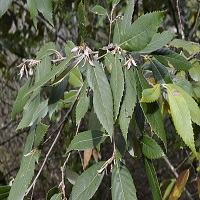 Sheesam, Dhak, Sisoo, and Khair are the most visible trees found in Corbett. A lot
of other varieties are found around the park which contributes to the diversity
of species. The only conifer found in the park is Chir Pine, and is seen on ridge
tops like Chir Choti and declines in Gajar Sot. The higher reaches near Kanda shelters
Banj Oak growing, which is a typical Himalayan species. Kanju (Holoptelia Integrifolia),
Jamun (Syzygium Cumini) and Aamla (Emblica Officinalis) are seen growing in major
areas. Other main types of trees in Corbett Park
Sheesam, Dhak, Sisoo, and Khair are the most visible trees found in Corbett. A lot
of other varieties are found around the park which contributes to the diversity
of species. The only conifer found in the park is Chir Pine, and is seen on ridge
tops like Chir Choti and declines in Gajar Sot. The higher reaches near Kanda shelters
Banj Oak growing, which is a typical Himalayan species. Kanju (Holoptelia Integrifolia),
Jamun (Syzygium Cumini) and Aamla (Emblica Officinalis) are seen growing in major
areas. Other main types of trees in Corbett Park
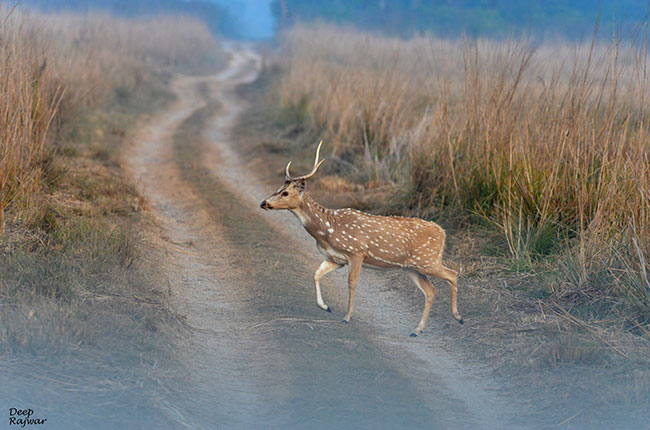
Corbett National Park is home for many wonderful as well as endangered species of
animals. The natural bounty and vast landscapes provide perfect habitat for wildlife
here.
Royal Bengal Tiger, Asian Elephant, Spotted Deer, Barking Deer, Chital, Sambar Deer,
Wild Boar, Black Faced Monkey, Rheus Monkey, Wild Pig and Jackal etc.
Peacock, Jungle Foul, White Bush Chat, Oriental Pied, Emerald Dove, Red Wattle Lapwing,
the Asian Paradise Flycatcher, Rested Kingfisher, Indian Shirks, Indian Alpine Swift,
Woodpecker, laughing Thrush, Vulture, Parakeet, kales Pheasant, Oriole, Common Grey
Hornbill, Duck, Stork, Cormorant, Parrot, Indian Roller, Teal, Seagull etc.
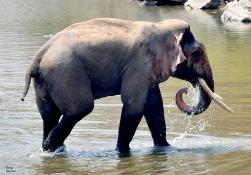
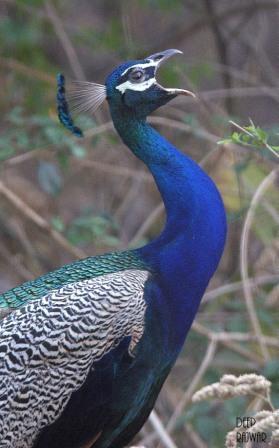
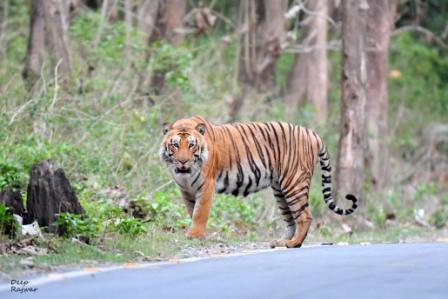
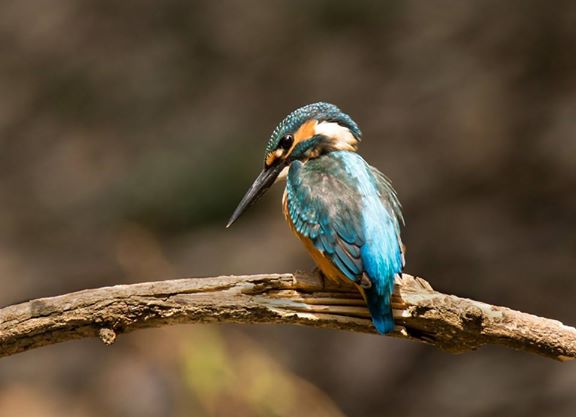
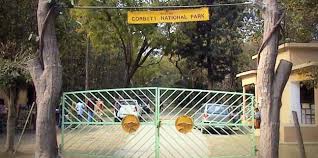
Durga Devi Gate
Ramnagar is a small town and municipal board in the Nainital District of Uttarakhand,
India. Ramnagar is located approximately 65 Kms (40 miles) from Nainital, the headquarters
of the district. Ramnagar is the Gateway to the Corbett Tiger Reserve, the oldest
National park.

Domunda Village
Corbett Tiger Reserve is one of the richest bird regions of India. Nearly 600 species
of birds also make Corbett a special place. Sightings of birds species like the
Collared falconet, Great Hornbill, Lesser Racket-tailed Drongo and white-tailed
Rubythroat are avid birdwatcher's delight.
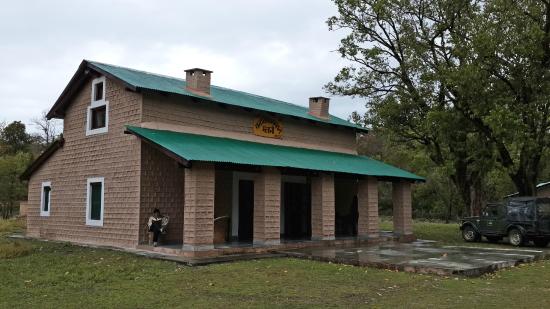
Lohar Chaur FRH
Bijrani Forest Rest House has strategic location at the Jim Corbett National Park's
core zone. The Forest Rest House is open for tourists and wild life lovers from
15 October to 15th June of every year. The entry gate to Bijrani zone is Aamdanda
gate.
Flora & Fauna
Trees like the Sheesam (Dalbergia sissoo), the Kanju (Holoptelea integrifolia),
the ber (Zizyphus mauritians), dhak (Butea monosperma), and bael (Aegle Marmelos).
A large number of tiger are said to be found here. Other mammals inhabiting Jim
Corbett National park includes deer species (Barking Deer, Sambar, Hog and Chital),
Sloth and Himalayan Black bears.
Tariff
|
Room Name
|
Indian
|
Foreigner
|
|
DORMITRY
|
₹ 250
|
₹ 500
|
|
FRH-Single Bed
|
₹ 500
|
₹ 1000
|
|
FRH-Double Bed
|
₹ 1250
|
₹ 2500
|
|
FRH-Four Bed
|
₹ 2000
|
₹ 4000
|
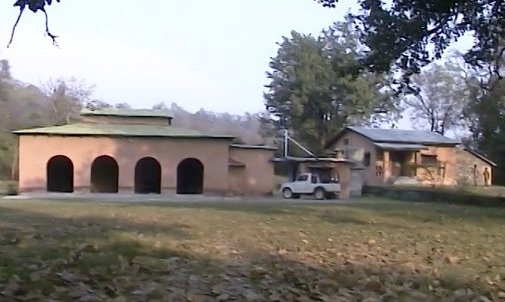
Rathuadhab FRH
Jhirna is located on the southern periphery of Corbett Tiger Reserve. It is one
of the man animal conflict zone years ago. Jhirna was one of the three villages
which have been relocated to other places for the sake of the conflict. This particular
zones village namely Jhirna, Dhara and Kothirau transformed into densely forested
and grassland habitat which is excellent for bird viewing.
Flora & Fauna
Trees like the Sheesam (Dalbergia sissoo), the Kanju (Holoptelea integrifolia),
the ber (Zizyphus mauritians), dhak (Butea monosperma), and bael (Aegle Marmelos).
A large number of tiger are said to be found here. Other mammals inhabiting Jim
Corbett National park includes deer species (Barking Deer, Sambar, Hog and Chital),
Sloth and Himalayan Black bears.
Tariff
|
Room Name
|
Indian
|
Foreigner
|
|
DORMITRY
|
₹ 250
|
₹ 500
|
|
FRH-Single Bed
|
₹ 500
|
₹ 1000
|
|
FRH-Double Bed
|
₹ 1250
|
₹ 2500
|
|
FRH-Four Bed
|
₹ 2000
|
₹ 4000
|

Jhirna FRH
Jhirna is located on the southern periphery of Corbett Tiger Reserve. It is one
of the man animal conflict zone years ago. Jhirna was one of the three villages
which have been relocated to other places for the sake of the conflict. This particular
zones village namely Jhirna, Dhara and Kothirau transformed into densely forested
and grassland habitat which is excellent for bird viewing.
Flora & Fauna
Trees like the Sheesam (Dalbergia sissoo), the Kanju (Holoptelea integrifolia),
the ber (Zizyphus mauritians), dhak (Butea monosperma), and bael (Aegle Marmelos).
A large number of tiger are said to be found here. Other mammals inhabiting Jim
Corbett National park includes deer species (Barking Deer, Sambar, Hog and Chital),
Sloth and Himalayan Black bears.
Tariff
|
Room Name
|
Indian
|
Foreigner
|
|
DORMITRY
|
₹ 250
|
₹ 500
|
|
FRH-Single Bed
|
₹ 500
|
₹ 1000
|
|
FRH-Double Bed
|
₹ 1250
|
₹ 2500
|
|
FRH-Four Bed
|
₹ 2000
|
₹ 4000
|

Halduparao FRH
Jhirna is located on the southern periphery of Corbett Tiger Reserve. It is one
of the man animal conflict zone years ago. Jhirna was one of the three villages
which have been relocated to other places for the sake of the conflict. This particular
zones village namely Jhirna, Dhara and Kothirau transformed into densely forested
and grassland habitat which is excellent for bird viewing.
Flora & Fauna
Trees like the Sheesam (Dalbergia sissoo), the Kanju (Holoptelea integrifolia),
the ber (Zizyphus mauritians), dhak (Butea monosperma), and bael (Aegle Marmelos).
A large number of tiger are said to be found here. Other mammals inhabiting Jim
Corbett National park includes deer species (Barking Deer, Sambar, Hog and Chital),
Sloth and Himalayan Black bears.
Tariff
|
Room Name
|
Indian
|
Foreigner
|
|
DORMITRY
|
₹ 250
|
₹ 500
|
|
FRH-Single Bed
|
₹ 500
|
₹ 1000
|
|
FRH-Double Bed
|
₹ 1250
|
₹ 2500
|
|
FRH-Four Bed
|
₹ 2000
|
₹ 4000
|

Mohan FRH
Jhirna is located on the southern periphery of Corbett Tiger Reserve. It is one
of the man animal conflict zone years ago. Jhirna was one of the three villages
which have been relocated to other places for the sake of the conflict. This particular
zones village namely Jhirna, Dhara and Kothirau transformed into densely forested
and grassland habitat which is excellent for bird viewing.
Flora & Fauna
Trees like the Sheesam (Dalbergia sissoo), the Kanju (Holoptelea integrifolia),
the ber (Zizyphus mauritians), dhak (Butea monosperma), and bael (Aegle Marmelos).
A large number of tiger are said to be found here. Other mammals inhabiting Jim
Corbett National park includes deer species (Barking Deer, Sambar, Hog and Chital),
Sloth and Himalayan Black bears.
Tariff
|
Room Name
|
Indian
|
Foreigner
|
|
DORMITRY
|
₹ 250
|
₹ 500
|
|
FRH-Single Bed
|
₹ 500
|
₹ 1000
|
|
FRH-Double Bed
|
₹ 1250
|
₹ 2500
|
|
FRH-Four Bed
|
₹ 2000
|
₹ 4000
|

Vatanvasa Gate
Corbett Tiger Reserve is one of the richest bird regions of India. Nearly 600 species
of birds also make Corbett a special place. Sightings of birds species like the
Collared falconet, Great Hornbill, Lesser Racket-tailed Drongo and white-tailed
Rubythroat are avid birdwatcher's delight.

Maidavan Gate
Ramnagar is a small town and municipal board in the Nainital District of Uttarakhand,
India. Ramnagar is located approximately 65 Kms (40 miles) from Nainital, the headquarters
of the district. Ramnagar is the Gateway to the Corbett Tiger Reserve, the oldest
National park.